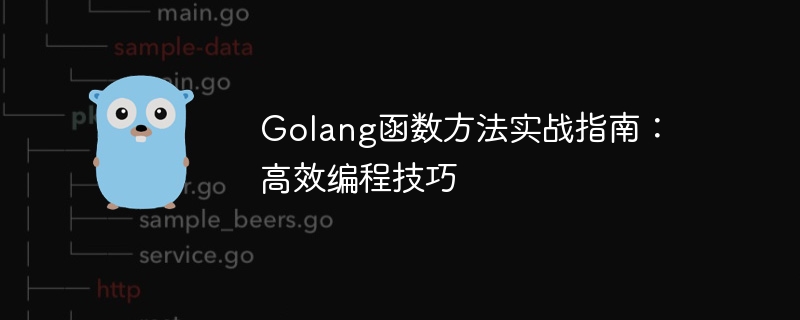Home >Backend Development >Golang >A Practical Guide to Golang Function Methods: Efficient Programming Techniques
A Practical Guide to Golang Function Methods: Efficient Programming Techniques
- PHPzOriginal
- 2024-03-12 13:18:03697browse

In recent years, with the widespread application of Golang in the field of software development, more and more developers have begun to pay attention to and learn this language. In Golang, functions and methods are very important concepts and are crucial to writing efficient and elegant code. This article will share some practical guidelines on Golang function methods, including efficient programming techniques and specific code examples, hoping to provide some help and inspiration to Golang developers.
1. Basic concepts of functions and methods
In Golang, a function is an independent code block used to implement specific functions. Functions can receive parameters and return results. A method is a function associated with a structure or type, and a function and a type are associated through a receiver. Method is an important concept in object-oriented programming (OOP) and is widely used in Golang.
2. The difference between functions and methods
There are some important differences between functions and methods in Golang. Functions exist independently, while methods must be attached to a type. Methods implement method calls by associating specific types, while functions can be called directly. In practice, developers need to choose whether to use functions or methods according to specific situations to achieve conciseness and efficiency of the code.
3. Efficient programming skills
- Use anonymous functions: Golang supports the use of anonymous functions. You can directly define and call functions when needed, avoiding code redundancy and complexity. .
func main() {
add := func(a, b int) int {
return a + b
}
result := add(2, 3)
fmt.Println(result)
}- Function closure: Closure refers to an entity composed of a function and its related reference environment. Closures can be used to encapsulate and protect data and improve code security and maintainability.
func add() func(int) int {
sum := 0
return func(x int) int {
sum += x
return sum
}
}
func main() {
adder := add()
fmt.Println(adder(1)) // 输出1
fmt.Println(adder(2)) // 输出3
}4. Sample Application: Student Performance Management System
Suppose we need to implement a student performance management system, including two basic data structures: students and courses. We can achieve this function by defining structures and methods.
type Student struct {
ID int
Name string
Age int
Grade int
Courses []string
}
func (s *Student) AddCourse(course string) {
s.Courses = append(s.Courses, course)
}
func (s *Student) GetAverageGrade() float64 {
sum := 0
for _, grade := range s.Courses {
sum += grade
}
return float64(sum) / float64(len(s.Courses))
}
func main() {
student := Student{
ID: 1,
Name: "Alice",
Age: 18,
Grade: 90,
Courses: []string{"Math", "Physics", "English"},
}
student.AddCourse("Biology")
fmt.Println(student.GetAverageGrade())
}Through the above examples, we can see how to use structures and methods to implement a student performance management system. This design makes the code clear, modular, and easy to maintain and expand.
5. Summary
In Golang, functions and methods are the key to writing efficient and elegant code. By learning and mastering the relevant knowledge and skills of functions and methods, developers can better apply the Golang language and implement applications with rich functions and excellent performance. We hope that the practical guide and code examples provided in this article can help readers better understand and apply Golang's function methods and improve programming capabilities and efficiency.
The above is the detailed content of A Practical Guide to Golang Function Methods: Efficient Programming Techniques. For more information, please follow other related articles on the PHP Chinese website!

